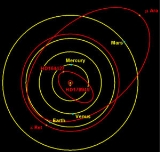
HD 179949 b
Encyclopedia
HD 179949 b is an extrasolar planet
discovered by the Anglo-Australian Planet Search
at the Anglo-Australian Observatory
, which orbits the star
HD 179949
. The planet is a so-called "hot Jupiter
", a Jupiter-mass planet orbiting very close to its parent star. In this case, orbital distance is almost one-tenth that of Mercury
from the Sun. One orbital revolution lasts only about 3 day
s.
Its magnetic field induces a bright spot on its star at 30 degrees latitude, which rotates at 87 degrees inclination. If the planet orbited at 83-97 degrees, then its transit would be visible from Earth. The angle of inclination is therefore 83 degrees or less, but not much less; and its mass is constrained to not much more than 0.923±0.077. The planet is not tidally locked to the star.
Assuming the planet is perfectly grey with no greenhouse or tidal effects, and a Bond albedo of 0.1, the temperature would be 1533 K
. This is, like Tau Boötis b, hotter than the predicted temperature of HD 209458 b
(1392K), and close to that of HD 149026 b
, before they were measured.
Searches for water in the planet's atmosphere have been inconclusive, as have attempts to determine whether titanium and vanadium oxides are present.
HD 179949 b is a candidate for "near-infrared characterisation.... with the VLTI Spectro-Imager".

Extrasolar planet
An extrasolar planet, or exoplanet, is a planet outside the Solar System. A total of such planets have been identified as of . It is now known that a substantial fraction of stars have planets, including perhaps half of all Sun-like stars...
discovered by the Anglo-Australian Planet Search
Anglo-Australian Planet Search
The Anglo-Australian Planet Search or AAPS is a long-term astronomical survey started in 1998 and continuing to the present. It is being carried out on the 3.9m Anglo-Australian Telescope, AAT, of the Anglo-Australian Observatory in Australia. The purpose of this survey is to catalog planets around...
at the Anglo-Australian Observatory
Anglo-Australian Observatory
The Australian Astronomical Observatory , formerly the Anglo-Australian Observatory, is an optical/near-infrared astronomy observatory with its headquarters in suburban Sydney, Australia...
, which orbits the star
Star
A star is a massive, luminous sphere of plasma held together by gravity. At the end of its lifetime, a star can also contain a proportion of degenerate matter. The nearest star to Earth is the Sun, which is the source of most of the energy on Earth...
HD 179949
HD 179949
HD 179949 is a 6th magnitude star in the constellation of Sagittarius. It is a yellow-white dwarf , a type of star hotter and more luminous than our Sun...
. The planet is a so-called "hot Jupiter
Hot Jupiter
Hot Jupiters are a class of extrasolar planet whose mass is close to or exceeds that of Jupiter...
", a Jupiter-mass planet orbiting very close to its parent star. In this case, orbital distance is almost one-tenth that of Mercury
Mercury (planet)
Mercury is the innermost and smallest planet in the Solar System, orbiting the Sun once every 87.969 Earth days. The orbit of Mercury has the highest eccentricity of all the Solar System planets, and it has the smallest axial tilt. It completes three rotations about its axis for every two orbits...
from the Sun. One orbital revolution lasts only about 3 day
Day
A day is a unit of time, commonly defined as an interval equal to 24 hours. It also can mean that portion of the full day during which a location is illuminated by the light of the sun...
s.
Its magnetic field induces a bright spot on its star at 30 degrees latitude, which rotates at 87 degrees inclination. If the planet orbited at 83-97 degrees, then its transit would be visible from Earth. The angle of inclination is therefore 83 degrees or less, but not much less; and its mass is constrained to not much more than 0.923±0.077. The planet is not tidally locked to the star.
Assuming the planet is perfectly grey with no greenhouse or tidal effects, and a Bond albedo of 0.1, the temperature would be 1533 K
Kelvin
The kelvin is a unit of measurement for temperature. It is one of the seven base units in the International System of Units and is assigned the unit symbol K. The Kelvin scale is an absolute, thermodynamic temperature scale using as its null point absolute zero, the temperature at which all...
. This is, like Tau Boötis b, hotter than the predicted temperature of HD 209458 b
HD 209458 b
HD 209458 b is an extrasolar planet that orbits the Solar analog star HD 209458 in the constellation Pegasus, some 150 light-years from Earth's solar system, with evidence of water vapor....
(1392K), and close to that of HD 149026 b
HD 149026 b
HD 149026 b is an extrasolar planet approximately 257 light-years away in the constellation of Hercules. The planet was discovered after it transited its parent star, HD 149026...
, before they were measured.
Searches for water in the planet's atmosphere have been inconclusive, as have attempts to determine whether titanium and vanadium oxides are present.
HD 179949 b is a candidate for "near-infrared characterisation.... with the VLTI Spectro-Imager".


